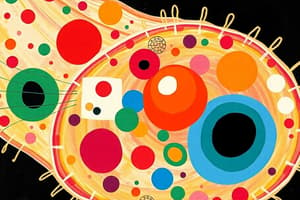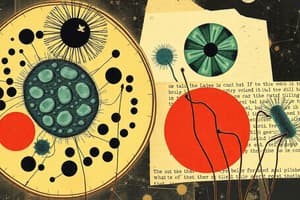Podcast
Questions and Answers
What is the main function of mitochondria in a cell?
What is the main function of mitochondria in a cell?
- Protein synthesis (correct)
- Energy generation
- Gene regulation
- Waste management
What is the process by which cells generate energy in the absence of oxygen?
What is the process by which cells generate energy in the absence of oxygen?
- Fermentation (correct)
- Cellular respiration
- Homeostasis
- Photosynthesis
What is the term for the thread-like structures that carry genes?
What is the term for the thread-like structures that carry genes?
- Genes
- Ribosomes (correct)
- Mitochondria
- Chromosomes
Flashcards are hidden until you start studying
Study Notes
Cells
- Basic structural and functional units of life
- Consist of:
- Cell membrane (plasma membrane)
- Cytoplasm
- Genetic material (DNA or RNA)
- Types of cells:
- Prokaryotic cells (no true nucleus)
- Eukaryotic cells (true nucleus)
Cell Organelles
- Mitochondria: generate energy for the cell through cellular respiration
- Endoplasmic reticulum (ER): involved in protein synthesis and transport
- Ribosomes: site of protein synthesis
- Lysosomes: contain digestive enzymes for breaking down cellular waste
- Golgi apparatus: involved in protein modification and transport
Genetics
- DNA (deoxyribonucleic acid): genetic material that stores information
- RNA (ribonucleic acid): involved in protein synthesis and gene regulation
- Genes: segments of DNA that code for specific traits
- Chromosomes: thread-like structures that carry genes
- Meiosis: process of cell division that results in gametes with unique genetic combinations
Evolution
- Change in species over time through natural selection and genetic drift
- Mechanisms of evolution:
- Mutation
- Gene flow
- Genetic drift
- Natural selection
- Evidence for evolution:
- Fossil record
- Comparative anatomy
- Molecular biology
Ecosystems
- Communities of organisms and their environment
- Components of an ecosystem:
- Biotic factors (living organisms)
- Abiotic factors (non-living environment)
- Energy flow:
- Producers (autotrophs)
- Consumers (heterotrophs)
- Decomposers
Biological Molecules
- Carbohydrates: energy storage molecules (e.g., glucose)
- Proteins: structural and functional molecules (e.g., enzymes)
- Lipids: energy storage molecules (e.g., fats)
- Nucleic acids: genetic material (DNA and RNA)
Biological Processes
- Photosynthesis: process of converting light energy into chemical energy
- Cellular respiration: process of generating energy from glucose
- Fermentation: process of generating energy in the absence of oxygen
- Homeostasis: maintenance of a stable internal environment
Cells
- Cellular components: cell membrane, cytoplasm, and genetic material (DNA or RNA)
- Cell membrane: regulates what enters and leaves the cell
- Cytoplasm: jelly-like substance inside the cell membrane where metabolic processes occur
- Genetic material: DNA or RNA that stores information for cellular functions
Cell Organelles
- Mitochondria: generate energy through cellular respiration, converting glucose into ATP
- Endoplasmic reticulum (ER): synthesizes and transports proteins
- Ribosomes: site of protein synthesis, reads mRNA and builds polypeptide chains
- Lysosomes: breaks down cellular waste and debris using digestive enzymes
- Golgi apparatus: modifies, packages, and transports proteins and lipids
Genetics
- DNA: double-stranded helix, genetic material that stores information
- RNA: single-stranded, involved in protein synthesis and gene regulation
- Genes: segments of DNA that code for specific traits, passed from parents to offspring
- Chromosomes: thread-like structures that carry genes, composed of DNA and proteins
- Meiosis: process of cell division that results in gametes with unique genetic combinations
Evolution
- Definition: change in species over time through natural selection and genetic drift
- Mechanisms of evolution:
- Mutation: changes in DNA sequence
- Gene flow: movement of genes between populations
- Genetic drift: random changes in gene frequency
- Natural selection: selection of traits that enhance survival and reproduction
- Evidence for evolution:
- Fossil record: shows gradual changes in species over time
- Comparative anatomy: similarities and differences between body structures
- Molecular biology: similarities and differences between DNA and protein sequences
Ecosystems
- Definition: communities of organisms and their environment
- Components of an ecosystem:
- Biotic factors: living organisms, including producers, consumers, and decomposers
- Abiotic factors: non-living environment, including temperature, light, and water
- Energy flow:
- Producers: autotrophs that convert light energy into chemical energy
- Consumers: heterotrophs that obtain energy by consuming other organisms
- Decomposers: break down dead organic matter, releasing nutrients back into the environment
Biological Molecules
- Carbohydrates: energy storage molecules, composed of carbon, hydrogen, and oxygen
- Proteins: structural and functional molecules, composed of amino acids
- Lipids: energy storage molecules, composed of fatty acids and glycerol
- Nucleic acids: genetic material, composed of DNA and RNA
Biological Processes
- Photosynthesis: process of converting light energy into chemical energy, occurs in chloroplasts
- Cellular respiration: process of generating energy from glucose, occurs in mitochondria
- Fermentation: process of generating energy in the absence of oxygen, occurs in cytoplasm
- Homeostasis: maintenance of a stable internal environment, regulation of temperature, pH, and other factors
Studying That Suits You
Use AI to generate personalized quizzes and flashcards to suit your learning preferences.



